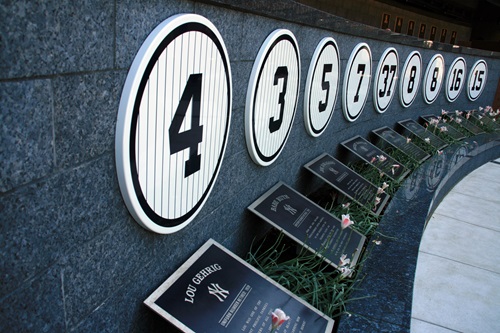
85 years ago, Lou Gehrig stood on home plate at Yankee Stadium and spoke the words that would be imprinted on the minds of baseball fans everywhere: “For the past two weeks, you have been reading about a bad break. Yet today, I consider myself the luckiest man on the face of the earth.”
It might have been Gehrig’s formal retirement but he has never been far from the public eye, even all these years later. His number was the first ever to be retired. His words about being lucky have outlived him. And amyotrophic lateral sclerosis (ALS), the disease that would rob him of his physical abilities, and within only two years, would rob him of his life, now also bears his name.
It’s something that, every day, weighs on the mind of Elijah Stommel, M.D., Ph.D, a neurologist who specializes in caring for ALS patients. Stommel is on a quest to find out how Gehrig developed ALS, and he’s looking at a possible culprit: the ground beneath Gehrig’s feet.

“Basically, we are trying to find historical details regarding turf management practices used during the 17 years that Lou Gehrig played baseball in Yankee Stadium,” noted a representative of Stommel’s lab. “We would want to know details regarding the types of pesticides, herbicides, fertilizers or any other additives used on the turf during the career of ‘The Iron Horse,’ which ran between 1923 and 1939.”
And Stommel is wondering if the sports business industry’s baseball history buffs, or those with groundskeeping experience, might have some insights. Have any? Report it to NeuroResearch@hitchcock.org.
Stommel is learning from today’s patients, and, in part, applying that knowledge to the past. His research lab, located at Dartmouth-Hitchcock Medical Center in Lebanon, New Hampshire, focuses on understanding the potential causes of ALS. Unfortunately, the genetic and environmental causes of ALS remain largely a mystery with most cases considered sporadic.
And the concept of the study is a recent one, says Dr. Stommel.
“We just started looking into it in the last month. It is simply a historical/scientific question of interest; we are interested in risk factors for ALS and Lou Gehrig is certainly one of the best known victims of the disease.”
Over the years, some suggestions have been made. In 2018, for instance, a research paper published by the National Library of Medicine-National Center for Biotechnology Information put forth the idea that, because there had been clusters of patients who were former rugby, soccer and football patients, these athletes could have been exposed to microorganisms in the dirt, grass and dust of the playing fields. In particular, Mycobacterium avium subspecies paratuberculosis (MAP) was being studied. MAP is found in the manure of species known as ruminants; these include cattle, sheep, goats and deer (among others).
In 2022 a Harvard Health Study came up with some interesting statistics: Between 1960 and 2019, 19,423 men played in the NFL. During that time period, 38 were diagnosed with ALS and 28 died of the disease. Among these current and former football players, the risk of developing ALS and dying of the disease was nearly four times higher than that of men in the general population, and men were diagnosed at a significantly younger age. Additionally, NFL players who developed ALS were those whose football career had been longer than average (seven years), as opposed to those without the disease (4-1/2 years).
Importantly, this study did not assess why there might be a relationship between ALS and playing professional football. The study authors speculated that traumatic brain injury might be to blame. Additionally, it is essential to note that this was an observational study. Observational research can identify a link between a possible risk factor (in this case, playing in the NFL) and a disease (ALS); however, it cannot be proved that the risk factor caused the disease.
The Harvard researchers also noted that additional risk factors for (note: not causes of) ALS that included smoking, genetics, pesticide exposure, unusual infections (including certain bacteria or viruses) and serious bodily injury.
It’s the pesticides and other environmental factors that have become Stommel’s focus, and what he is studying closely in his quest to unlock a few answers in Gehrig’s case. One statement from his lab notes that Stommel’s research on today’s patients includes enormous amounts of screening to uncover data on exposure to various substances.
“Our research team has established a large biorepository that has enrolled ALS and unaffected control cases in Ohio and Northern New England (New Hampshire and Vermont). We have collected various types of biospecimens (including blood, hair, toenail clippings, urine, saliva, teeth, central nervous system tissue, etc.) in order to evaluate genetic biomarkers as well as toxins found within these samples.
 In addition, questionnaires are gathered on subjects to evaluate a variety of demographic, lifestyle, behavioral (i.e., hobbies and activities) and occupational factors. Also, our lab often estimates residential exposure to environmental toxins at various time periods prior to disease diagnosis. Using geographic information system (GIS) analysis, our team focuses on the correlation of ALS with the geospatial prevalence of various toxins in the surrounding environment.”
In addition, questionnaires are gathered on subjects to evaluate a variety of demographic, lifestyle, behavioral (i.e., hobbies and activities) and occupational factors. Also, our lab often estimates residential exposure to environmental toxins at various time periods prior to disease diagnosis. Using geographic information system (GIS) analysis, our team focuses on the correlation of ALS with the geospatial prevalence of various toxins in the surrounding environment.”
It's a tall order to find out about the grass management practices in effect at Yankee Stadium between 1923 and 1939, when Gehrig played there. Was manure used on the soil at some point? Possibly; it was certainly a popular additive in landscaping (and continues to be, today). If so, that could dovetail with the hypothesis of the research from the National Library of Medicine mentioned earlier.
And it could have been the case at multiple ballparks, since historically, fertilizer came from natural or organic sources: compost, animal manure, etc. It is not only possible, but probable, that plenty of other athletes were exposed to manure and the microorganisms present in it.
Yet Gehrig was the only player diagnosed at that time, something that adds another layer of complexity to the mystery of ALS. And Stommel, for one, is not seeking a smoking gun. This is, he notes, almost a cold case but one that interests those who want to follow the past for clues to the present.
“It is of historical interest and to some degree, of medical/neurological interest.”
But that makes it no less interesting. As National Geographic noted recently (in an article about an entirely different mystery), “That’s the difference between armchair CSI fans and actual forensic scientists: A scientist wants to know the right answer, even if it’s mundane. But if you think about it, it’s actually pretty exciting that nature hands us clues to what would otherwise probably remain cold cases.”
Over the past few decades, two other high-profile baseball players, Hall of Famer Jim “Catfish” Hunter, and former Boston College captain Pete Frates, were diagnosed with ALS. Hunter died in 1999 and Frates in 2019. (Before his death, Frates championed the Ice Bucket Challenge that became a social media phenomenon and raised more than $220 million; that amount went into research and helped scientists identify 12 genes that play a critical role in ALS, discoveries which, in turn, could open the door to potential treatments and therapies.)
Of course, over the years, plenty of other theories have arisen. One was that Gehrig did not have ALS at all; another was that he had CTE brought on by not only his years in baseball but his time as a college football player.
One often mentioned, though easily debunked, theory is that one early insecticide, (dichloro-diphenyl-trichloroethane (DDT) was the cause of Gehrig’s illness. The EPA’s records indicate that DDT was first synthesized in 1874 but its effectiveness as an insecticide was only discovered in 1939 – the year Gehrig retired.
Also, contrary to some information, Gehrig was not the first person to be diagnosed with ALS; the disease was originally identified in 1869 by French neurologist Jean-Martin Charcot, but it wasn’t until Gehrig’s diagnosis that it became widely known.
Dr. Stommel’s lab is looking for all kinds of leads and is encouraging those who have information (seriously, any information) to send it to NeuroResearch@hitchcock.org.

